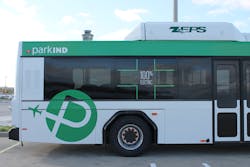Matt Horton, chief commercial officer for Proterra, a manufacturer of electric buses , said the technology is used in some capacity at more than 100 transit agencies in North America, so it’s a proven mode of transportation with lots of examples for airports to look at when considering it.
Transit agencies are moving quickly towards full electrification of their fleets and Horton said airports are now on the heels of that change for the same reasons.
“Airports are constantly looking for ways to improve the customer experience,” he said. “They also know that they want to be leading on climate and other emissions reductions and with better electric buses they are, really, for the first time, able to get a vehicle that can do all of the work that they need, deliver a great customer experience and do it very cost effectively.”
An appealing option
Electric buses are more appealing to airports because the cost of batteries has decreased, Horton said, so an electric bus has dropped from $1.2 million to about $700,000, making it competitively priced while the technology has matured so it can now be used on any type of route an airport could think to use it on.
Federal funding sources like the VALE Grant and FAA ZEV program can finance the cost of buses and charging equipment.
Indianapolis International Airport (IND) launched electric buses as part of its shuttle bus fleet in 2017. Five more will be added in 2018 and another three in 2019, which will bring the total electric bus fleet to nine for the airport.
Mario Rodriguez, executive director, Indianapolis Airport Authority, said the entire fleet will be electrified as it will lower the airport’s carbon footprint by 15 million pounds per year.
Rodriguez said the airport will save 66,000 gallons of diesel fuel on an annual basis. Coupled with maintenance savings, IND will see a $2 million annual saving by using electric buses.
Rodriguez said communities want leaders to be good stewards of the environment, so it’s important for the airport to respect those needs.
“We started looking at things at the airport a little bit differently. Less through a financial equation lens and more towards a public value lens,” he said. “If we align with what our community wants, who actually owns the airport, we have a strategic win.”
IND was able to purchase six of the electric buses after it was awarded $2.6 million ZEV grant in 2016. It collected another $1 million in ZEV funding in 2017 to purchase three more units.
Build by Complete Coach Works, the buses are remanufactured units using a traditional bus chassis, which is completely stripped down and rebuilt. Seven plug-in areas were installed to recharge the buses at the end of their shifts.
“They can handle about 120 miles, which gives us an eight to 12 hour shift,” Rodriguez said. “Once they’re done, they go into their little area, they get plugged in and in about six hours, they’re ready to go again.”
Horton said airports are looking to use electric buses for rental car shuttles and parking lot shuttles, so travelers would be met with a quiet, modern bus as opposed to a loud diesel bus spewing emissions at them.
Now some are also looking to implement for employee shuttles and some are now looking at electric buses for airside operations as well.
“For most airport operations, they’re looking to use a vehicle that can run all day and charge in a brief window overnight, say three to four hours,” Horton said. “They just need a standard EV plug in charger to do that.”
For airports with 24 hour operations, Horton said there are also in-route charging system options so the bus is refueled during brief layovers periodically during the day.
The buses use lithium ion batteries, Horton said, which have a similar lifecycle as a regular electric vehicle. Proterra recommend battery upgrades at the midlife of the bus, which is around six to eight years, but the batteries are under warranty for 12 years and will continue to operate for the full 12 years, though they will lose some of their original capacity.
“When we do all of the economic analysis for a customer we do
“That lines up well with what they’re used to in doing overhauls of their vehicles to repower or replace a power plant on a CNG or diesel bus,” he said.
“That market has been moving very quickly in the direction of full electrification of their fleet. We see airports coming right on the heels of where those public transit agencies are going, “he said.
Mineta San Jose International Airport (SJC) announced in November it’s purchasing 10 electric buses from Proterra to shuttle travelers on the landside of the facility.
Bob Swensen, landside operations manager for SJC, said the airport began looking at electric buses to replace its CNG fleet in 2016 after leaders became aware of federal grants to fund the purchase of the vehicles.
The airport won a $3.8 million ZEV grant and used it to pay 50 percent of the purchase cost. The airport provided the other half of the cost.
Swensen said SJC sought just six buses, but the FAA alerted them to additional funds, so they opted to replace the entire CNG fleet in one swift action.
SJC chose Proterra after putting out a request for bid (RFB) and a rebate program made it the lowest cost of the electric buses on the market.
Swensen said SJC shares green initiatives with the city of San Jose and the implementation of electric buses helps meet the initiatives. It also provides a cost savings of about $4 million during the 12-year lifetime of the buses.
“The only thing we needed to talk about with the proposers was the battery life,” Swensen said. “We do run our buses 20 hours per day and we were concerned about how often we would have to charge the batteries to keep them operation, but the companies that we spoke to put our fears to rest that we are not going to have issues with charging the buses, that they could run for long periods of times and service our needs.”
Kanas City International Airport (MCI) put four electric buses in service in 2017 to service its parking lot shuttles. The BYD-manufactured buses mark the beginning of a replacement of the airport’s current compressed natural gas (CNG) fleet, which has been in operation at MCI for nearly 20 years.
Kenneth Williams, fleet maintenance superintendent for MCI, said the airport started looking at electric vehicles about four years ago during its regular purchasing process. The Federal Aviation Administration (FAA) had placed an electric vehicle grant under its VALE program, which made the switch enticing.
The total investment for the buses for MCI was $1.8 million.
“We were exposed to electric transit and kept investigating what was out there and how it worked and more and more realized this would be a good place to use that because we’re a controlled environment,” Williams said.
Ian Redhead, deputy director of aviation for MCI, said the electric buses cost about 30 cents per mile to operate compared to 80 cents per mile for the CNG buses. The airport discovered the cost of maintaining the CNG buses went up over time, so there was an additional cost savings by switching to electric.
“What we first looked as was the possibility of taking one of our existing CNG buses and having it retrofitted to an electric vehicle,” Redhead said. “But, then you got into the question of if you retrofit a vehicle is it then considered a new vehicle and would it qualify for the grant. That’s why we switched over to strictly looking at the purchase of the new vehicles.
Redhead said MCI opted for BYD buses because of the warranty and guaranty was longer than some of the other electric bus manufacturers were willing to give the airport. He said the battery life is also longer than others they investigated.
“This one is not a lithium ion battery and that’s one of the reasons we went to it and it’s not considered at the end of useful life it’s not considered a hazardous battery” he said. “We went and looked at the plant in Los Angeles and we were impressed with the technology and everything that went into building the vehicles.”
Plan for the future
Indianapolis is using the electric buses to shuttle passengers between the terminal and remote parking lots. Rodriguez said the goal is to eventually use them for all passenger and employee movements to the terminal.
“It elevates our customer experience to a great extent,” Rodriguez said. “They’re comfortable, they’re quite, the acceleration is constant and it really is a fantastic experience for the customer compared to a normal diesel bus.”
Rodriguez said an electric motor is about the simplest and full proof motors out there, so there was little concern from leaders in moving to the alternative fuel source.
“What people are worried about is change,” he said. “We want to make sure as an organization that we accept change and accept change for the benefit of our customers and the community and so forth.
IND built a marketing program for the buses to tout their alternative fuel power plant by creating a wrap for the buses to show them the positive message the buses create.
“Automatically, everybody gravitates down to the lowest common denominator, which is cost and return on investment. You can always find a cheaper, less environmentally-friendly solution to everything. That’s not an argument,” Rodriguez said. “The argument should we as public entities and CEOs of public entities strive to give our communities what they really want which is a cleaner environment and the answer is yes.
SJC initially looked at installing in-route charging with the buses, but Swensen said they determined it was unnecessary because the buses could get adequate charge when parked at night.
The buses were expected to come into service at SJC either late in 2018 or early 2019. Swensen said there’s a delay in delivering the units because the airport does have some left side door stops on its routes, so Proterra has to build a bus to accommodate SJC, which is still subject to Altoona testing.
San Jose will hold onto its old CNG buses after the electric units come into service. With the growth at the airport, they may use them for shuttling passengers on the airside.
Williams said they built out charging facilities for the electric buses at MCI as part of plans to purchase more units in the coming years.
Williams said BYD assisted with training MCI bus operators and maintenance personnel on the new technology.
“People being afraid has been one of the biggest challenges. Running out of power is the same as running out of gas,” he said. “Once they get past some of those issues, I’ve noticed driver fatigue is down after hours of driving one because you’re not getting a pulsation or any push from the transmission or shifting or downshifting and they don’t have that sound bothering them anymore.”







